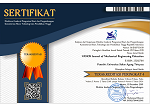The Influence of YouTube Learning Media with Observation Method and Self-Confidence on Learning Outcomes of Heavy Equipment Technology
Abstract
Keywords
Full Text:
PDFReferences
A. Saputra, “Pendidikan Dan Teknologi: Tantangan Dan Kesempatan,” Indones. J. Islam. Educ. Manag., vol. 3, no. 1, pp. 21–33, 2020, doi: 10.24014/ijiem.v3i1.9095.
A. Sarıçoban, I. Tosuncuoğlu, and Ö. Kırmizi, “A technological pedagogical content knowledge (TPACK) assessment of preservice EFL teachers learning to teach English as a foreign language,” J. Lang. Linguist. Stud., vol. 15, no. 3, pp. 1122–1138, 2019, doi: 10.17263/jlls.631552.
A. H. Anaelka, “Education 4.0 Made Simple: Ideas For Teaching,” Int. J. Educ. Lit. Stud., vol. 6, no. 3, p. 92, 2018, doi: http://dx.doi.org/10.7575/aiac.ijels.v.6n.3p.92.
F. Orgaz, S. Moral, and C. Domínguez, “Student’s Attitude and Perception with the Use of Technology in the University,” J. Educ. Psychol. - Propos. y Represent., vol. 6, no. 2, pp. 277–299, 2018, doi: http://dx.doi.org/10.20511/pyr2018.v6n2.230.
S. Wiegreffe and Y. Pinter, “Attention is not not Explanation,” Comput. Lang., vol. 148, pp. 148–162, 2019, [Online]. Available: https://arxiv.org/abs/1908.04626.
F. Almeida and J. Simoes, “The role of serious games, gamification and industry 4.0 tools in the education 4.0 paradigm,” Contemp. Educ. Technol., vol. 10, no. 2, pp. 120–136, 2019, doi: 10.30935/cet.554469.
C. Mohd, C. Nuraini, F. Shahbodin, N. Pee, and C. Hanapi, “Personalized Learning Environment (PLE) Experience in the 21st Century: Review of Literature,” Pattern Anal. Intell. Secur. Internet Things, pp. 179–192, 2015, doi: 10.1007/978-3-319-17398-6_17.
H. Abizar, M. Fawaid, M. Nurtanto, S. Nurhaji, and S. Setiyani, “Local Wisdom-Based 4-ON (Vision, Action, Passion, and Collaboration) Model in Competencies of Machining technique in Vocational Secondary Schools,” J. Pendidik. Teknol. dan Kejuru., vol. 27, no. 1, pp. 48–56, 2021, doi: https://doi.org/10.21831/jptk.v27i1.33197.
H. Cigdem and M. Ozturk, “Critical components of online learning readiness and their relationships with learner achievement,” Turkish Online J. Distance Educ., vol. 17, no. 2, pp. 98–109, 2016, doi: 10.17718/tojde.09105.
Y. Fitriyani, I. Fauzi, and M. Z. Sari, “Motivasi Belajar Mahasiswa Pada Pembelajaran Daring Selama Pandemik Covid-19,” Profesi Pendidik. Dasar, vol. 7, no. 1, pp. 121–132, 2020, doi: 10.23917/ppd.v7i1.10973.
E. Nurhayati, “Penerapan Buku Saku dengan Pendekatan Saintifik untuk Meningkatkan Motivasi dan Hasil Belajar Siswa Pasca Gempa Bumi,” J. Kependidikan J. Has. Penelit. dan Kaji. Kepustakaan di Bid. Pendidikan, Pengajaran dan Pembelajaran, vol. 5, no. 2, p. 94, 2019, doi: 10.33394/jk.v5i2.1804.
A. R. Fauzi and R. Al Atok, “PENGUATAN KARAKTER RASA INGIN TAHU DAN PEDULI SOSIAL MELALUI DISCOVERY LEARNING A,” J. Teor. dan Praksis Pembelajaran IPS, vol. 2, no. 2, pp. 27–36, 2017, doi: 10.17977/um022v2i22017p079.
R. Rosdiana, “Pengembangan Media Pembelajaran Berbasis Komputer,” Al-Khwarizmi J. Pendidik. Mat. dan Ilmu Pengetah. Alam, vol. 1, no. 2, pp. 87–100, 2018, doi: 10.24256/jpmipa.v1i2.95.
I. W. K. Wati, A. S. Sari, W. Widodo, and R. Setyaningsih, “Media Need Analysis of Learning Practicum in the Covid-19 Pandemic,” VANOS (Journal Mech. Eng. Educ., vol. 5, no. 2, pp. 155–162, 2020, doi: http://dx.doi.org/10.30870/vanos.v5i2.
L. Sari, “Upaya Menaikkan Kualitas Pendidikan dengan Pemanfaatan Youtube Sebagai Media Ajar Pada Masa Pandemi Covid-19,” J. Tawadhu, vol. 4, no. 1, p. 1074, 2020.
F. Puspitorini, “Strategi Pembelajaran Di Perguruan Tinggi Pada Masa Pandemi Covid-19,” J. Kaji. Ilm., vol. 1, no. 1, pp. 99–106, 2020, doi: 10.31599/jki.v1i1.274.
D. Sinaga and S. I. Putri Sinaga, “Pengaruh Kemampuan Guru Dalam Penggunaan Media Pembelajaran Daring Terhadap Hasil Belajar Siswa,” J. Inov. Penelit., vol. 2, no. 3, pp. 873–879, 2021, doi: https://doi.org/10.47492/jip.v2i3.772.
H. Mujianto, “Pemanfaatan Youtube Sebagai Media Ajar Dalam Meningkatkan Minat Dan Motivasi Belajar,” J. Komun. Has. Pemikir. dan Penelit., vol. 5, no. 1, pp. 135–159, 2019, doi: http://dx.doi.org/10.10358/jk.v5i1.588.
Rusman, Belajar dan Pembelajaran Berorientasi Standar Proses Pendidikan. JAKARTA: Kencana, 2017.
T. Hermayanti, “Peningkatan Kepercayaan Diri Melalui Kegiatan Menari Kreatif,” JPUD - J. Pendidik. Usia Dini, vol. 9, no. 2, pp. 389–400, 2015, doi: https://doi.org/10.21009/JPUD.092.12.
H. Hendriana, “Membangun Kepercayaan Diri Siswa Melalui Pembelajaran Matematika Humanis,” J. Pengajaran Mat. dan Ilmu Pengetah. Alam, vol. 19, no. 1, p. 52, 2014, doi: 10.18269/jpmipa.v19i1.424.
F. Nuriansyah, “Efektifitas Penggunaan Media Online Dalam Meningkatkan Hasil Belajar Pada Mahasiswa Pendidikan Ekonomi Saat Awal Pandemi Covid-19,” J. Pendididikan Ekon. Indones., vol. 1, no. 2, pp. 61–65, 2020.
DOI: http://dx.doi.org/10.30870/vanos.v6i2.12608
Refbacks
- There are currently no refbacks.

This work is licensed under a Creative Commons Attribution 4.0 International License.


.png)
.png)
